|
Dasyatidae (whiptail stingrays)
Life
> Eukaryotes >
Opisthokonta
> Metazoa (animals) >
Bilateria >
Deuterostomia > Chordata >
Craniata > Vertebrata (vertebrates) > Gnathostomata (jawed
vertebrates) > Chondrichthyes > Elasmobranchii > Batoidei >
Myliobatoidei
These flat stingrays have a whiplike tail
without dorsal or caudal fins. 61 species, 13 in the area.
Species found in southern Africa
|
Dasyatis brevicaudatus (Shorttail stingray) A huge, thick, plain stingray with a bluntly
angular snout and pectoral disk with rounded tips, thick-based tail
less than body length (longer in young), and a small upper and long
lower caudal finfold, the lower not reaching tail tip. Disk smooth
except for a large slender thorn on tail in front of stings; often
two stings, the front one small, the rear sting huge. Colour
grey-brown or bluish-grey above, with a row of small
pale blue spots at each pectoral fin base, white below,
tail plain |
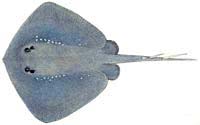 |
|
Dasyatis chrysonota (Blue stingray) An angular stingray with conspicuous bright
blue blotches and branching lines on a golden brown disk. Snout and
disk angular, tail less than twice body length, a short upper caudal
finfold and a longer lower one which falls far in front of tail tip,
disk without thorns, and usually 1 sting. Underside white, tail
darker and without bands. |
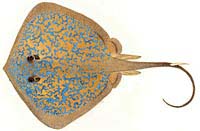 |
|
Dasyatis kuhlii (Bluespotted stingray) A small colourful angular stingray with small,
round, bright blue eyespots on a reddish-brown background, tail only
as long as body and with conspicuous black and white rings. Snout
very short and broadly angular, disk angular, a short upper caudal
finfold and a longer lower one that ends well behind tail tip, disk
without thorns, and usually one sting on tail. Underside white. |
 |
|
Dasyatis thetidis (Thorntail stingray) A huge plain dark stingray with a broadly
angular snout and pectoral disk, thick-based tail tapering to a
slender whip much longer than body length, no upper caudal finfold
but a long lower caudal finfold that ends far in front of tail tip,
and upper disk and tail roughened by large flat thorns in large
juveniles and adults (absent in small individuals); 1 or 2 stings on
tail. |
 |
|
Himantura sp. near fai (Roundnose stingray) A plain dark angular stingray with a bluntly
pointed snout, long slender tail over twice body length when intact,
no caudal finfolds, and no large thorns. A band of small flat
denticles along midback and usually one medium-sized sting on tail.
Colour black to grey-blue above, underside white, tail without
contrasting bands. |
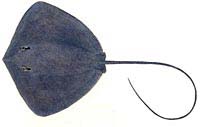 |
|
Himantura gerrardi (Sharpnose stingray) A plain light angular stingray with a sharply
pointed snout, long slender tail over twice body length when intact,
no caudal finfolds, and no large thorns. A band of small flat
denticles along midback and usually one medium-sized sting on tail.
Colour light brown above, white below, tail with transverse bands of
light and dark brown which may fade in adults. |
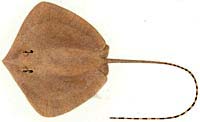 |
|
Himantura jenkinsii (Dragon stingray) An angular stingray with a conspicuous band of
enlarged, erect, hooked, rough thorns on midline of disk, small dark
brown spots on rear margin of disk, and no caudal finfolds. Snout
angular, disk with broadly rounded tips, tail slender and slightly
greater than body length, and a single sting on tail. Colour brown
above, with light rear margin, tail darker, disk white below with
darker tan margin. |
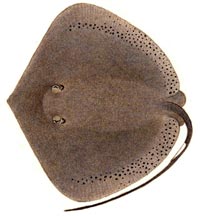 |
|
Himantura cf.
marginata (Dark whipray) |
|
|
Himantura cf. uarnak (Honeycomb stingray) A huge angular stingray with conspicuous dark
spots on a light brown disk, these well-spaced in young but crowded
to form a reticulated pattern in adults, and bands of black and
white on its tail. Snout sharply pointed, outer corners of disk
narrowly rounded, long slender tail nearly three times body length
when intact, no caudal finfolds, disk without thorns but with a band
of flat denticles along midback in adults and usually one
medium-sized sting on tail. Underside white. |
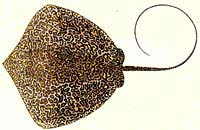 |
|
Pastinachus sephen (Feathertail stingray) A large dark, plain angular stingray with a
long, broad based tail with a high lower caudal finfold 2 to 3 times
depth of tail but not reaching tail tip. Snout and disk angular,
tail less than twice body length, no upper finfold, no large thorns,
and one or two long stings on tail, these farther behind tail base
than most other stingrays. Has unique hexagonal, high-crowned rough
teeth that may allow it to grind and crush harder prey than most
other stingrays. Colour brown or black above but without distinctive
markings, underside white. |
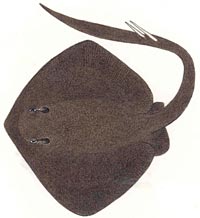 |
|
Pteroplatytrygon
violacea (Pelagic stingray) A dark thick stingray, uniformly
purplish-violet or dark blue-green on both surfaces. Snout broadly
rounded but pectoral disk angular, eyes not protruding from head
(unlike other stingrays, which have froglike periscopic eyes), tail
less than twice body length and with a long lower caudal finfold
that ends far in front of tail tip but no upper fold. Disk without
thorns, usually one extremely long sting on tail. |
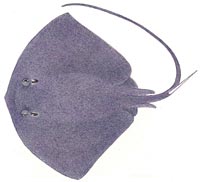 |
|
Taeniura lymma (Bluespotted ribbontail ray) A colourful stingray with large bright blue
spots on its elongated oval disk and blue side stripes along its
tail. Snout rounded-angular, outer corners of disk broadly rounded,
tail stout, tapering, less than twice body length when intact, a
broad lower caudal finfold that reaches tail tip, no large thorns
but with small flat denticles along midback in adults, and usually
one medium-sized sting on tail further behind its base than in most
stingrays. Colour grey-brown to yellow or reddish brown above,
underside white. |
 |
|
Taeniura meyen (Round ribbontail ray) A huge dark circular stingray with dark grey to
black blotches and spots, a short stout tapering tail about as long
as body length, and a broad lower caudal finfold that reaches tail
tip. Snout broadly rounded, outer corners of disk broadly rounded,
disk without thorns but covered by small star-shaped denticles in
adults, and one or two medium-sized stings on tail. Colour blue-grey
above with grey to black spots and blotches, white below. |
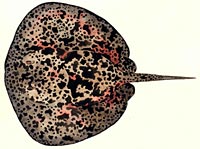 |
|
Urogymnus asperrimus (Porcupine ray) A stingless, heavily armoured stingray with an
elongated, oval, white to light grey disk and slender blackish tail
without finfolds. Snout broadly rounded, disk very thick with
broadly rounded outer corners, tail about as long as body. Young
have large flat denticles on upper surface; large juveniles and
adults develop additional huge sharp conical thorns and small
pointed denticles, making them extremely rough and difficult to
handle. Underside white. |
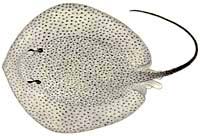 |
Text by Leonard J.V. Compagno, David A. Ebert
and Malcolm J. Smale
|
